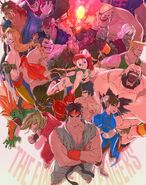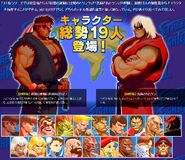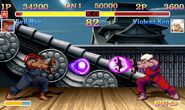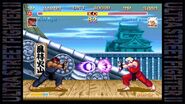(Described above.) |
Rare Hunter (talk | contribs) No edit summary |
||
| Line 11: | Line 11: | ||
|genre = [[wikipedia:Fighting game|Fighting]] |
|genre = [[wikipedia:Fighting game|Fighting]] |
||
|modes = [[wikipedia:Single-player|Single-player]], [[wikipedia:Multiplayer video game|Multiplayer]] |
|modes = [[wikipedia:Single-player|Single-player]], [[wikipedia:Multiplayer video game|Multiplayer]] |
||
| + | |ratings = '''CERO''': B<br>'''ESRB''': T (Teens)<br>'''OFLC''': M<br>'''PEGI''': 12+ |
||
| − | |ratings =66% (Metacritic) |
||
| ⚫ | |||
|platforms = [[wikipedia:Nintendo Switch|Nintendo Switch]] |
|platforms = [[wikipedia:Nintendo Switch|Nintendo Switch]] |
||
|media = |
|media = |
||
| Line 51: | Line 50: | ||
==Reception== |
==Reception== |
||
| + | {|class="wikitable sortable" align=right |
||
| + | !Site |
||
| + | !Score |
||
| + | |- |
||
| + | |''Metacritic'' |
||
| + | |66% |
||
| + | |- |
||
| ⚫ | |||
| + | |8.5/10 |
||
| + | |} |
||
The game has received mixed reviews; among other complaints it was criticized for charging a US$40 retail release for being "essentially an updated port of the much cheaper ''Super Street Fighter II Turbo HD Remix''", its functionality of the Joy-Con controllers (with critics pointing out issues with the Joy-Con's D-Pad and analog stick controls) and the "Way of the Hado" mode's poorly implemented motion controls that are prone to confusing attack inputs for other attacks, as well as being shallow in content. |
The game has received mixed reviews; among other complaints it was criticized for charging a US$40 retail release for being "essentially an updated port of the much cheaper ''Super Street Fighter II Turbo HD Remix''", its functionality of the Joy-Con controllers (with critics pointing out issues with the Joy-Con's D-Pad and analog stick controls) and the "Way of the Hado" mode's poorly implemented motion controls that are prone to confusing attack inputs for other attacks, as well as being shallow in content. |
||
| Line 67: | Line 76: | ||
==Videos== |
==Videos== |
||
{{inc1}} |
{{inc1}} |
||
| − | <gallery> |
+ | <gallery widths=300> |
All_20_Endings!!!_Ultra_Street_Fighter_II_The_Final_Challengers |
All_20_Endings!!!_Ultra_Street_Fighter_II_The_Final_Challengers |
||
</gallery> |
</gallery> |
||
Revision as of 09:08, 4 June 2018
Ultra Street Fighter II: The Final Challengers is a 2D fighting game developed and published by Capcom for the Nintendo Switch. Released worldwide on 26 May 2017, it is an updated version of 1994's Super Street Fighter II Turbo. The game features two graphical styles—classic pixel art and updated high-definition art. New gameplay mechanics and modes were also introduced, with minor changes being made to the game's balance in addition to adding Evil Ryu from the Street Fighter Alpha series and Violent Ken from SNK vs. Capcom: SVC Chaos to the roster. There are no current plans for the game to release on other consoles unless the game sells well on the Nintendo Switch.[2]
Gameplay
There are two graphic options, which are "Classic" and "New Style" graphics. The latter option (also known as "New Generation Mode") reuses UDON's redrawn sprites and stage backgrounds from HD Remix. Their ending artwork is also implemented regardless of which graphic option is chosen. Conversely, the characters' portrait arts under either option are remastered from the originals.
The game has the option to have special moves and supers on the ready by assigning them to four buttons that can be pressed once to activate that special move.
There is also a Dramatic Battle Mode, called "Buddy Battle", that was featured in home versions of Street Fighter Alpha games, which allows two players to face CPU opponents together.[3]
As with the graphics, there are both Classic and New Style sound options to choose between. Classic sound settings' sounds remain the same as the previous Street Fighter II update series.
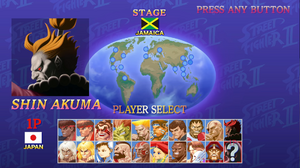
Character select screen with Shin Akuma being selected.
If the sound setting is in New Style, however, the characters will use the Japanese voice actors and sound effects from the current Street Fighter games since Street Fighter IV and onwards, rather than also having English voice actors while in that graphic mode. The game also features a new announcer voice heard in all modes of gameplay (including the Classic sound option), so as to accomodate the update's new features (added character names, the change of USSR to Russia [as per the official timeline], the title call at the end of the new opening sequence, and so forth). Additionally, a new soundtrack has been produced for the game, with the music being closer to Super Street Fighter II Turbo and not being remixes with unique styles. Despite this, the music heard in the endings of the pre-existing 17 characters is retained from HD Remix (this occurs even under Classic settings) as well as the staff roll theme that follows.
Two new characters have been added: Evil Ryu and Violent Ken. This marks Violent Ken's first appearance in a mainline Street Fighter game. Evil Ryu retains most of his moves from the Street Fighter Alpha games and his voice is an altered version of original Ryu's, sounding more demonic. Violent Ken has new tools carried over from SVC Chaos, such as his command teleport dash, Rasetsu Kyaku[4] and his voice is altered in the same manner as Evil Ryu's. Akuma is also now a regularly selectable character, while Shin Akuma is a secret character, sharing his slot with the newly added Random Select icon.
The game has a few changes from Super Street Fighter II Turbo. Teching throws is now possible[5]. The balance changes from HD Remix aren't returning for Ultra Street Fighter II, with characters retaining their gameplay from Super Street Fighter II Turbo. This means certain moves and changes from HD Remix, like the addition of Ryu's fake Hadoken and Zangief's Spinning Piledriver being a "180" motion are not in the game. Chun-Li and E. Honda can't store their supers.
Modes
The game features three new modes and one returning mode. The Way of the Hado mode is a first-person shooting gallery where players take control of Ryu and fight waves of Shadaloo soldiers using the Joy-Con motion controllers. To perform moves, they have to be mimicked with the controllers. Ryu can be improved in this mode using the Practice Mode, which lets players practice a fighter's moves and gain experience points to improve the following parameters: vital (health), attack, speed, guts, defense and luck.
The Arcade Mode has three stages: Beginner, Standard and Extra.
Gallery Mode features over 1400 illustrations from the official Street Fighter artbook, Street Fighter Artworks: Supremacy.
Color Edit mode allows players to make custom color schemes of a given fighter; up to ten colors can be saved for each custom character, which can be used in all game modes, including online.[6]
Development
Ultra Street Fighter II: The Final Challengers was announced for the Nintendo Switch console in January 2017 and marked the beginning to celebrate the series' 30th anniversary. The development team for the game is composed of a mixture of old and young employees, some of which worked on recent Capcom fighting games like Street Fighter V and Marvel vs. Capcom: Infinite.[7] With the last Street Fighter title to release on a Nintendo system being Super Street Fighter IV: 3D Edition for the Nintendo 3DS in 2011, Capcom saw the launch of the Nintendo Switch as an opportunity to bring a brand-new remixed version of a classic Street Fighter game to a Nintendo console.[7] The mindset of Ultra Street Fighter II's development was to allow a parent to introduce Street Fighter II to a newer generation.[8]
On February 14, 2017, the game was fifty percent complete.[9]
On the decision to revisit Street Fighter II, series producer Yoshinori Ono noted that they wanted to go back to their roots.[7] Capcom chose to include two graphical styles so that the game would give old players a sense of nostalgia but still appeal to a younger audience with the update art.[7] The game's high-definition graphics were created by Udon Entertainment. The development team did not want to overhaul the game's balance as they want the game to feel like a fighting game from the 1990s.[7] However, they felt that some questionable aspects of the game's balance should be re-tuned.[7]
Reception
| Site | Score |
|---|---|
| Metacritic | 66% |
| IGN Latinoamérica | 8.5/10 |
The game has received mixed reviews; among other complaints it was criticized for charging a US$40 retail release for being "essentially an updated port of the much cheaper Super Street Fighter II Turbo HD Remix", its functionality of the Joy-Con controllers (with critics pointing out issues with the Joy-Con's D-Pad and analog stick controls) and the "Way of the Hado" mode's poorly implemented motion controls that are prone to confusing attack inputs for other attacks, as well as being shallow in content.
Despite the negative reviews, according to Capcom the game is considered a "smash hit" in term of sales.[10]
Trivia
Gallery
Videos
References
- ↑ https://www.eventhubs.com/news/2017/mar/01/ultra-street-fighter-2-final-challengers-hits-nintendo-switch-may-26th/
- ↑ https://www.eventhubs.com/news/2017/jan/21/if-title-sells-extremely-well-well-consider-it-time-being-its-only-going-be-switch-ono-usf2-console-availability/
- ↑ https://www.nintendo.co.jp/software/switch/babba/index.html
- ↑ https://twitter.com/JWonggg/status/819932190972739585
- ↑ https://twitter.com/JWonggg/status/819930868600999936
- ↑ http://www.gamer.ne.jp/news/201702170010/
- ↑ 7.0 7.1 7.2 7.3 7.4 7.5 http://uk.ign.com/articles/2017/01/20/6-things-we-learned-about-ultra-street-fighter-ii-on-nintendo-switch
- ↑ https://www.eventhubs.com/news/2017/jan/15/capcom-wanted-dads-who-grew-street-fighter-2-play-new-version-together-their-children-ayano-talks-usf2-famitsu-interview/
- ↑ http://www.siliconera.com/2017/02/14/ultra-street-fighter-iis-fps-mode-will-shoryuken-hadouken-joy-cons/
- ↑ https://www.gamespot.com/articles/street-fighter-2-switch-called-a-smash-hit-as-capc/1100-6452075/

